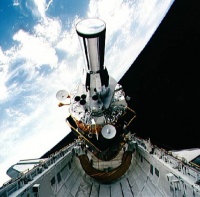USA 75
From The Space Library
 | |
| Organization | Department of Defense (United States) |
|---|---|
| Mission type | Surveillance and Other Military,Space Physics |
| Launch date | November 24, 1991 |
| Launch vehicle | STS-44 |
| Carrier rocket | Space Shuttle |
| Launch site | Cape Canaveral, United States |
| COSPAR ID | 1991-080B |
| Mass | 2355.0 kg |
| Alternate Names | DSP F16, Defense Support Program,21805 |
| Additional Information | Here |
| PDMP Information | Here |
| Telecommunications Information | Here |
This spacecraft is part of a continuing series of classified spacecraft. The three spacecraft USA 39 (1989-046A), USA 65 (1990-095A), and USA 75 (1991-080B) replace an earlier constellation of geosynchronous orbit spacecraft. These three were positioned at longitudes of approximately 195, 8, and 72 degrees, respectively, as of February 20, 1992. Each spacecraft carries two instruments whose data are available for magnetospheric research: the Magnetospheric Plasma Analyzer (MPA) and the Synchronous Orbit Particle Analyzer (SOPA). The article by McComas et al., "Magnetospheric plasma analyzer: Initial three-spacecraft observations from geosynchronous orbit, (J. Geophys. Res., 98, No. A8, p. 13453, 1993) gives more information. It also declares: "Recently, the MPA and SOPA data sets have become part of the International Solar Terrestrial Physics (ISTP) program with the inclusion of key parameter data in the ISTP Central Data Handling Facility (CDHF). These data should provide a valuable adjunct to ISTP science, particularly in light of the lack of a dedicated `Equator' spacecraft, in addition to providing new information about the geosynchronous environment in their own right.
